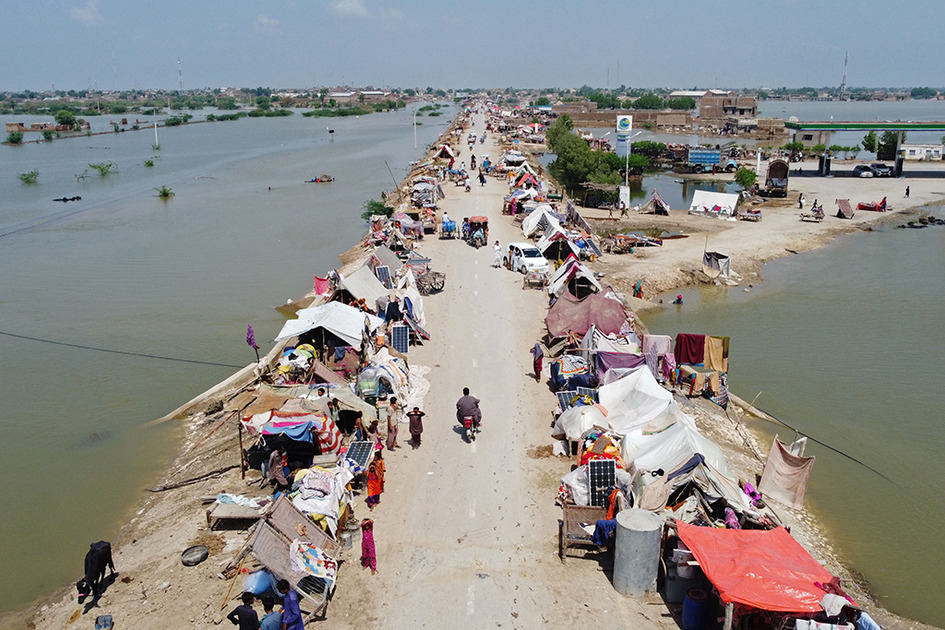As aptly described by the U.N. chief Antonio Guterres, Pakistan has been hit by a “monsoon season on steroids.” Images of men on a submerged house calling for help, as well as a viral video showing the massive many-foot-high waves that brought down a hotel in Swat, will linger in people’s minds for weeks, but the country’s leadership, unfortunately, will not learn all of the lessons it should have. The fact that climate change exists has hit Pakistan with full force as an unusually heavy monsoon caused havoc in the region, killing thousands and displacing millions in India and Bangladesh. Areas of Sindh and Balochistan received huge volumes of rainfall. Sindh received some 700mm, nearly six times the 30-year annual average, and Balochistan has received five times the yearly average. Pakistan, by the end of August, had received three times its usual annual average rainfall, and over 1,300 people have died from the floods so far. Over 30 million people have been displaced as large swathes of its territory (up to one-third) were flooded, 200 bridges and 3,000 miles of telecom lines have collapsed or been damaged, and the cost of damage has been estimated at upwards of $10 billion.
The rain struck after months of drought the country faced, compounding the situation, as the ground was hard and did not absorb the incessant strong rains, the water became a flood moving over the ground instead. But projections for the region by the UN Intergovernmental Panel on Climate Change suggest this: As temperatures rise worldwide, there will be increasing rates of drought, which, along with an increase in the total amount of rain, will see an increased frequency and intensity of precipitation across the region. Pakistan also contains more than 7,200 of the world’s glaciers—more than any other place outside the poles—and they are melting away every day, drip by drip.
Scenes in Pakistan were similar to those seen during the 2010 floods when over 2,000 people died, and losses ran into billions. The climate change minister, Sherry Rehman, has criticized western countries for the ills they committed in the 19th and 20th centuries and called upon them to make reparations and help pay for developing countries to adapt to climate shocks. However, the reality is that successive governments in Pakistan have not done enough to develop methods to manage an issue they knew the country was exposed to since 2010. Many lessons could have been learned from Bangladesh, a low-lying country that suffers from annual flooding of varying severity that has done much work on flood defense.
Many elderly people will remember the Bhola cyclone of 1970, which killed an estimated 500,000 Bengalis and ultimately played a crucial role in tearing the country asunder. Bangladesh saw catastrophic floods in 1974, 1987, 1988 and 1998, when even Dhaka was inundated. A similar one hit Bangladesh two years ago; Cyclone Amphan killed fewer than 100 people. The country has, over the decades, worked on two key areas that help to avoid the major impact of any cyclone: infrastructure and early-warning systems.
Regulate Infrastructure
Bangladesh has invested in flood defenses for years to protect its low-lying coastal regions from cyclones. People living near the coasts have been encouraged to make houses that would off er more resistance to floods and go further inland. In Pakistan’s case, due to lack of regulation and often corruption of bureaucrats to turn the other eye, many of the houses that were washed away were built on inland nullahs, which were meant to provide water passageways for precisely the scenario that happened. All this is compounded by the huge population pressure that the country faces, which creates unsustainable and under-regulated development of housing colonies.
Develop better early warning systems
Bangladesh has teams of people that gather weather data down to the micro level of communities or villages, which predict floods days in advance. Nowadays, even a basic smartphone offers technology to tell people the weather up to a couple of weeks in advance. The government has set up a system in which residents are informed through text messages, and the loudspeakers of mosques are being used to tell people to leave their homes and go to a safe place. The government has even trained people to help in such emergencies.
Pakistan did some work on early-warning systems after the 2010 flash floods, which did help lower the death toll from the current floods. But much more needs to be done. A regular analysis needs to be conducted on the performance of the National Disaster Management Authority, the basic structure of which was set up after the 2005 earthquake. NDMA manages the whole Disaster Management Cycle (DMC), which includes Preparedness, Mitigation, Risk Reduction, Relief, and Rehabilitation. In general, it has been both understaffed and under-resourced. While its remit includes disaster prevention work and post-event responsibility, the success evaluation matrix is unclear.
Disaster planning is not sexy and generally does not win votes, so Pakistani governments usually ignore it until a crisis is upon them. But as weather patterns change and disasters become more common and affect areas not used to such extremes, Pakistan will have to be better prepared for future “unexpected” events. Ironically, while Pakistan is one of the lowest contributors to climate change, it is one of the most impacted by it. Pakistan is currently the chair of the group of 77 developing countries plus China; the annual U.N. climate talks will be held in Egypt in November, and Pakistan should use it as an opportunity to ask rich countries to do more financially to help developing countries pick up the tab for climate change modifications they need to make.





